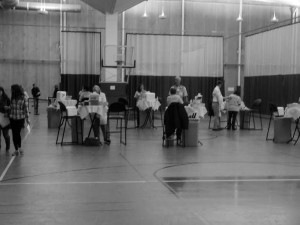 Each year, 5-20% of the American population is diagnosed with the flu. Approximately 200,000 citizens are hospitalized due to flu symptoms, and the illness results in anywhere from 3,000 to 49,000 mortalities annually. Flu season generally begins in October and may continue until as late as May.
Each year, 5-20% of the American population is diagnosed with the flu. Approximately 200,000 citizens are hospitalized due to flu symptoms, and the illness results in anywhere from 3,000 to 49,000 mortalities annually. Flu season generally begins in October and may continue until as late as May.
Medical professionals recommend cleanliness as a key preventive method against the flu – washing hands frequently, avoiding contact with infected people, and properly disinfecting surfaces. But what else can we do? According to the Centers for Disease Control and Prevention, “annual vaccination is the most important measure to prevent seasonal influenza infection.”
Biologically speaking, flu vaccinations work by stimulating the recipient’s immune system to be ready to neutralize the flu virus as soon as it enters the body. Without the injection, the flu virus may establish itself in the body, causing a slew of uncomfortable and even painful symptoms including fatigue, body aches, fever, runny nose, sore throat, and chills.
Every year, University Health Services (UHS) makes a concerted effort to ensure that UR’s students, staff, and faculty community avoid this uncomfortable and potentially deadly affliction.
On Thursday, Oct. 30, UHS worked with the Medical Emergency Response Team (MERT) and director of UR Environmental Health & Safety, Chief Safety Officer, and Fire Marshal Mark Cavanaugh to administer 1,924 flu shots at a rate of approximately 240 vaccinations per hour to UR students and staff.
Each year, MERT practices an emergency rescue drill as part of their eagerness to increase preparedness for emergency situations. This year the organization focused on a simulated flu epidemic. Although UHS has flu vaccinations avaliable to students throughout the fall, this mass administration – the first of its kind at the University – increased the number of students who were vaccinated, according to Associate Director of UHS Ann McMican. McMican currently serves as Point of Distribution Manager for flu vaccination on campus.
In 2009, over 500 UR students were infected with the H1N1 virus, a unique strain of the flu that many feared would lead to a widespread epidemic. This year’s mass distribution of flu vaccinations was undertaken, in part, to ensure that the University is prepared to handle such outbreaks.
This year’s vaccine was particularly strong, containing antibodies against four strains of the flu rather than the usual three-strain vaccination. The doses were pre-ordered through the UR purchasing system last spring and stored in the large Pharmacy refrigerators until they were ready for administration, at which point they were transported to Goergen Athletic Center.
The vaccinations were covered by insurance for individuals with the Aetna Student Health insurance plan or for those with coverage through a private company, and were administered to anyone who filled out a consent form.
The mass vaccination system proved extremely efficient. Students were encouraged to print and complete consent forms prior to showing up for their shots, allowing them to move directly to the vaccination line upon arrival at the athletic center. But for those who did not pre-print their forms, the on-site process took only a few minutes.
McMican noted that in order to speed things up, students were instructed to remove their jackets while they waited in line. “That’s a rate limiting step for us,” she commented.
Students were then directed to one of ten stations, each with a nurse from UHS, to receive their shot. A doctor was present to oversee the process and help out with the administration. On their way out, students were rewarded with a bag of M&Ms and an “I got my flu shot today!” sticker.
Freshman Emma Briggs was eager to get her flu shot last week. “I always get a flu shot,” she said commenting on the risk of going without one. “You’re opening yourself up to illness that you could have easily avoided.” She was impressed by the efficiency of UR’s system. “You moved through quickly, and there were people stopping you and making sure you were doing alright,” she noted.
Briggs mentioned that she especially values her vaccination this year, as she realizes how easy it is to get the flu on a college campus, considering the close living quarters and large population. Mass vaccinations on college campuses are important for a number of other reasons.
Statistics show that people in the age group of 18-49 are the least likely to get flu vaccinations. Last year, 45.2% of people between the ages of six months and seventeen years old were vaccinated, 42.7% of people between 50 and 64 were vaccinated, and 66.5% of people of 65 years and older were vaccinated. Meanwhile, only 26.3% of people between 18 and 49-years-old received flu vaccinations. Initiatives like UHS’ mass administration are important for increasing these numbers.
At the conclusion of the emergency mass vaccination drill, UHS received a letter of commendation from Byron S. Kennedy, MD, PhD, MPH, and Commissioner of Public Health of Monroe County. He noted that Monroe County officials “observed a high degree of excellence in meeting CDC National Standards for State and Local Public Health Preparedness.”
“We want to keep everybody healthy, and this is a good way to do it,” McMican said. “The more in advance we prepare, the better.” UHS’ and MERT’s cohesive distribution of the vaccine was a huge success and hopefully will be continued in future years.
Kaplan is a member of the class of 2018.


